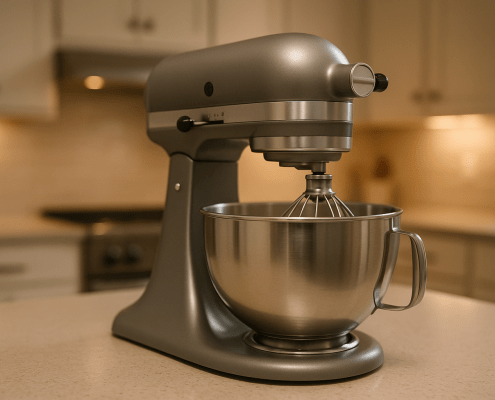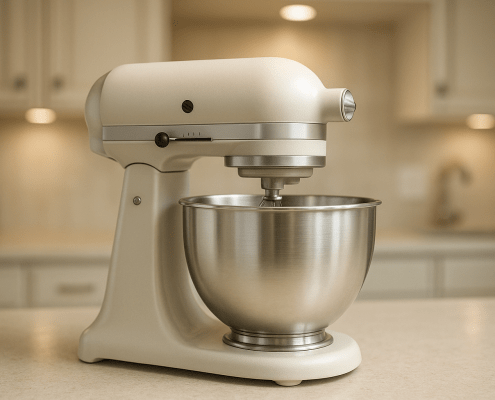How to replace KitchenAid mixer worm gear WP9709231
Steven E / Thursday February 8, 2024
Is your trusty KitchenAid stand mixer struggling to stir like it used to? Don’t worry, you might just have a worn-out worm gear! Before you rush to replace your mixer, check out our step-by-step video tutorial below on how to give your mixer a new lease on life with a simple DIY fix.
Is your KitchenAid stand mixer not mixing like it used to? It might be time to tackle the worm gear, that little gadget that keeps everything spinning smoothly.
The worm gear is part of the mixer’s gear system that drives the mixing action. Over time, the worm gear may become damaged, which can cause noise and trouble mixing.
Before you think about sending your mixer off to the appliance graveyard, you can try replacing the worm gear yourself.
If you need a replacement worm gear WP9709231, you can order it here. Looking for more stand mixer replacement parts? Just enter your model number at AppliancePartsPros.com to find what you need.
Let’s get your kitchen buddy back in action!
Watch: How to replace Whirlpool/KitchenAid/Maytag Worm Gear WP9709231
What you need
- Phillips screwdriver
- Small flathead screwdriver
- Snap ring pliers
- Punch
- Planetary gear grease
- New worm gear WP9709231 (make sure it’s compatible with your mixer model)
Disclaimer: The specific tools required may vary depending on the model of your appliance and the type of fasteners used on it. Always consult the user manual or refer to any specific instructions provided by the manufacturer for the recommended tools for your appliance model.
Read more: Must-Have Tools for Appliance Repair – DIY For Beginners
Safety precautions
When working on any appliance, remember to keep safety first. Here are some tips to keep in mind:
- Always power off and unplug your mixer or switch off the circuit breaker before attempting any maintenance or replacement work. This keeps you safe by preventing any risk of injury from electric shock.
- If the mixer has recently been used, give it plenty of time for any heating parts to cool down before working on it.
- When working with wires, avoid touching any exposed wires or terminals. If you need to touch a wire, use a non-conductive tool or wear insulating gloves to prevent electrical shock.
- Take your time and don’t rush while working to prevent accidents and personal injuries.
- Work in a well-lit area so you can clearly see and access the interior parts.
- Clear your workspace of clutter and other obstacles. Keep children and pets away from the work area.
- Never work on internal parts with wet hands. Make sure the work area is completely dry.
- Check your user manual to see if there are specific installation or safety instructions for your part or mixer.
- Be gentle when handling or removing parts. Excessive force might damage the mixer or cause injury.
- Wear safety glasses when working with chemicals, dust or cleaning large debris to prevent injury.
Read more: 8 Best Kitchenaid Stand Mixer Attachments
Replacement steps
Step 1 – Disassemble the mixer
- Make sure the mixer is unplugged.
- Make sure the bowl is in the lowest position.
- Lift the beater up by turning it clockwise until it drops down, then pull it out to remove it.
- Lift the bowl off the mounting pegs and pull it out.
- Find the screw at the back of the mixer that holds the trim in place. Use a Philips screwdriver to remove the screw.
- Pull the trim off and set it aside.
- Find the four screws (two on each side) that hold the cover on the mixer. Use a Philips screwdriver to remove all four screws and set them aside.
- Lift the cover off the mixer and set it aside.
- Find the two screws that hold the speed control board in place. Use a Philips screwdriver to remove the screws and lift the speed control board out of the way.
- Use a small flat-head screwdriver to release the tabs holding the sensor in place. Press on each side to release the tabs, then pull the sensor out of the motor.
- Swing the speed control board out of the way.
- Find the four screws that hold the transmission cover down. Use a Philips screwdriver to remove all four screws and set them aside.
- Lift the transmission housing off and set it aside.
- Take out the accessory drive gear, clean the grease off of it and set it aside.
- Lift off the old worm gear and bearings, clean any grease off, and set them aside.
- Slide the bearings off each end of the worm gear.
- Clean off all the grease from the gears and the drive shaft.
- Use snap ring pliers to carefully remove the snap ring without spreading it too far.
- Lift up on the beveled gear and set it aside.
- Use a punch to push out the pin that’s holding the worm follower gear in place. Clean it up and set it aside.
- Remove the worm follower gear by using a flat-head screwdriver to help work it up the shaft. Hold onto the planetary assembly below since it’ll come out as well. Clean it up and set it aside.
- Clean out the old grease from the housing.
Step 2 – Install the new worm gear
- Push in the planetary shaft bearing and make sure it’s correctly seated.
- Lift the planetary assembly back up.
- Grease the worm follower gear and set it down in place on the shaft. Attach it with the pin.
- Grease the external gear and the pinion gear before lifting the planetary up into the mixer.
- Set the worm follower gear onto the shaft and make sure the raised side is up, then insert the pin to hold it.
- Grease the bevel gear and set it onto the shaft. Make sure it’s aligned correctly so the snap ring can be placed back on.
- Attach the rear sleeve bearing, thrust bearing, and front sleeve bearing to the new worm gear. Check that the flats are vertical.
- Grease the new worm gear and set it into the gear case.
- Grease the accessory drive gear and place it back in the housing. Pack extra grease around the gears, but not in the housing.
- Put the transmission housing back on and attach it with screws.
- Remount the speed control board, plug in the sensor, and secure it with screws.
- Put the cover back on the mixer and attach it with the trim ring and screws.
- Put the bowl and beater back in place. Make sure the beater is locked in correctly.
- Plug the mixer back in and turn it on to test for any problems.
Read more: How To Clean And Maintain Your Stand Mixer
Additional information
Thanks for reading! We hope this guide helped you replace the worm gear in your KitchenAid stand mixer.
If you still need some replacement parts, grab your model number and head over to AppliancePartsPros.com. We offer over two million parts and most orders arrive in two business days. If you need some help with finding the right part or placing an order, you can contact our team at 1 (877) 477-7278.
While you’re waiting for your new part to arrive, you can explore our DIY blog and watch thousands of video tutorials on our YouTube channel.
Be sure to follow us on Facebook, Twitter and Instagram to see our latest repair guides!
With nearly a decade of experience in providing top-notch customer service regarding appliance parts and repair, Steven enjoys sharing practical advice, troubleshooting tips, and interesting information to help readers stay informed.





